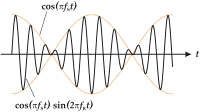
Photo from wikipedia
Harmonic complex tones contained in speech and music evoke a pitch at their fundamental frequency (F0). This pitch can be produced through either patterns of harmonics individually resolved by the… Click to show full abstract
Harmonic complex tones contained in speech and music evoke a pitch at their fundamental frequency (F0). This pitch can be produced through either patterns of harmonics individually resolved by the cochlear frequency analysis or periodicity in the amplitude envelope resulting from beating between neighboring harmonics. To investigate how these two pitch cues are coded in the auditory midbrain, we recorded from single units in unanesthetized rabbits in response to harmonic complex tones with varying F0 so as to create conditions where harmonics were likely resolved or unresolved. For F0 above 600 Hz, some neurons showed local maxima in firing rate when a low-order (<6-8) harmonic of F0 coincided with the neuron’s best frequency (BF), thereby providing a rate-place code to resolved harmonics similar to that found in the auditory nerve. For F0 below 800 Hz, some neurons showed rate tuning to a particular F0 unrelated to the BF. Altering the phase relationships among the harmonics showed that this nontonotopic...
Journal Title: Journal of the Acoustical Society of America
Year Published: 2017
Link to full text (if available)
Share on Social Media: Sign Up to like & get
recommendations!